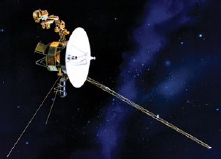1977
Voyager “Grand Tour” Begins
As robotic missions to the outer solar system were being contemplated in the late 1960s and early 1970s, mission planners and celestial dynamics experts realized that a fortuitous alignment of Jupiter, Saturn, Uranus, and Neptune would make it possible for a single probe to use gravity assists to potentially fly past all four giant planets in the 1970s and 1980s. This historic “grand tour” concept generated a lot of excitement among NASA researchers, and the idea was eventually implemented in a new pair of missions called Voyager.
Voyager 2 was launched first, on August 20, 1977, on a trajectory that would get it to Jupiter in mid-1979, Saturn in mid-1981, Uranus in early 1986, and Neptune in mid-1989. Voyager 1’s launch was on September 5, 1977, on a faster trajectory that would get it to Jupiter in early 1979 and Saturn in late 1980. Voyager 1’s tour included just Jupiter and Saturn flybys because the desire to perform a close flyby of Saturn’s large, thick-atmosphered moon Titan required a course correction that made it impossible to subsequently encounter Uranus and Neptune.
The missions of Voyager 1 and Voyager 2 are among the most exciting and successful adventures in the history of space exploration—or any other kind of exploration, for that matter. The probes enabled scientists to make new discoveries about the giant planets’ atmospheres, magnetic fields, ring systems, and their planet-size moons Io, Europa, Ganymede, Callisto, Titan, and Triton (plus many smaller moons). Voyager discoveries enabled even more discoveries at Jupiter and Saturn by the follow-on Galileo and Cassini orbiters, respectively, and provide the data needed for eventual orbital missions to Uranus and Neptune sometime in the future.

Artist’s conception of the Voyager spacecraft. The long piece extending to the lower right is the 42-foot (13-meter) boom for the magnetic field instrument.
Like the Pioneers, each Voyager also has a message in a bottle of sorts—a golden record, containing encoded images, voices, and music—a cosmic time capsule bearing greetings from planet Earth to whoever finds it in the far future.
SEE ALSO Jupiter (c. 4.5 Billion BCE), Saturn (c. 4.5 Billion BCE), Uranus (c. 4.5 Billion BCE), Neptune (c. 4.5 Billion BCE), Io (1610), Europa (1610), Ganymede (1610), Callisto (1610), Titan (1655), Saturn Has Rings (1659), Triton (1846), Pioneer 11 at Saturn (1979), Voyager 2 at Uranus (1986), Voyager 2 at Neptune (1989).
Montage of a Voyager Grand Tour trajectory diagram, superimposed on greatest-hits Voyager images of the giant planets.
